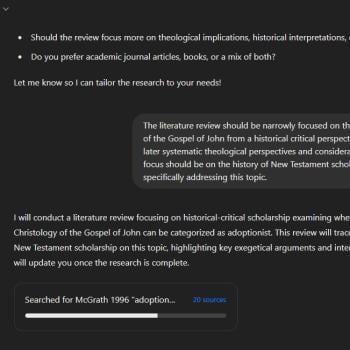I’ve finally found some time to post my second blog entry about chapter 10 of Earl Doherty’s book Jesus: Neither God Nor Man – The Case for a Mythical Jesus
. Here’s a link to my first post about this chapter. Ironically, even though I have written far more already on the first 1/6 of the book than one would ever find written about an entire book in a printed review, some mythicists have still complained that there are details in the book that I have not addressed. Since those complaints are a smokescreen trying to distract from the fact that the book’s shortcomings are so bad that they undermine anything positive that could be said about the book, presumably there is no point in trying any longer to be as comprehensive as possible. What good points there have been in the book thus far have typically been things that one can find in other books which consistently use a scholarly approach. And so from this point onward readers of this blog can expect me to focus entirely on the book’s many shortcomings, and can look elsewhere for other information.
This chapter at long last brings into the foreground something that is central to Doherty’s book: the question of where Jesus was believed to have been crucified (on earth vs. in a celestial realm). Also central to Doherty’s argument is a work known as The Ascension of Isaiah, which some have regarded as originally having been a Jewish text which Christian redactors made additions and changes to in order to adapt it to a Christian viewpoint, while others would say that the work is better viewed as resulting from the combination of Jewish and Christian works originally composed separately. There are several places online where one can read the text in English translation in whole or in part. The manuscript tradition is varied, and trying to solve the textual and literary issues is fraught with complexities. But if the oldest Jewish core is found in chs.1-5, there is no basis therein for Doherty’s claims about the pre-history of Christianity. The Christian version is dated by scholars to the second half of the second century at the earliest, and Doherty does not even address that conclusion or show awareness of it, much less present anything that might justify disagreeing with it. All he does is selectively quote from versions of the Ascension as it suits him, and implausibly posit that in some form the work is earlier than the New Testament writings.
This brings us to the crux of Doherty’s views. Doherty’s entire argument for mythicism can be viewed as an attempt to regard some parts of the Ascension of Isaiah as both the key to understanding the New Testament, and the fountainhead of what eventually became Christianity. At no point is the case he makes persuasive. Let me illustrate this point by point.
First, the Ascension of Isaiah in its Christian form has the descending Savior be transformed into the likeness of the various spheres into which he descends, including taking on the form of a baby in the womb of Mary. Doherty actually claims that the nativity account in the Ascension of Isaiah might be more primitive than that found in the New Testament Gospels, which no one who actually compares them will find remotely plausible. On the one hand, the Ascension largely follows and assumes the account in Matthew’s Gospel, while on the other, it adds to it secondary details of a docetic nature: the child simply emerges miraculously from the womb without labor, the child sucks at his mother’s breast merely so as to not be detected as a heavenly visitor, and the minds of others in the village are confused so that they do not perceive what is going on.
The work (particularly in the Ethiopic version containing such details) is plainly on the trajectory towards docetism, and perhaps itself appropriately viewed as docetic. And so is best situated in the period in which docetism arose, which fits with mainstream scholarship on the date of this form of the work.
Mythicism could be viewed as an attempt to claim that docetism was the original form of Christianity, but on the one hand its case for that is not at all compelling, and on the other hand, even works such as this one have the descending Redeemer take on the appearance of the spheres entered, and so in the forms in which we have it that include Christian components at all, the Savior appears in the human realm in human form. The Ascension of Isaiah therefore does not support Doherty’s claim for a crucifixion that takes place in a celestial realm. (And the same obviously applies to docetism in general, which posits an entity appearing in human history who seemed human to observers but really wasn’t, not the purely celestial entity that is part of Doherty’s mythical account of Christian origins.)
We see this in the relevant manuscripts of Ascension of Isaiah, where it says, “And after this the adversary envied Him and roused the children of Israel against Him, not knowing who He was, and they delivered Him to the king, and crucified Him, and He descended to the angel (of Sheol).”
And so, even if Doherty’s case for the primacy of the Ascension of Isaiah were to be found persuasive by someone, the text simply does not support his claims about the work’s view of the descending savior or about the character of early Christian belief. Like all other evidence, Doherty only cites the text selectively, and as usual he shows no sign of having familiarized himself with scholarship on this work, much less of having interacted with that scholarship in the necessary detail so as to draw persuasive conclusions and answer possible objections.
Towards the end of the chapter, Doherty once again uses the term “midrash” incorrectly, and while he and some of his defenders have tried to distract attention from this, it is crucially important. Doherty uses midrash not as the Jewish tradition does but as John Shelby Spong does, which seems in turn to be based on the manner that Barbara Thiering used the more specific term pesher. They all claim that people not only interpreted already-existing sacred texts in a manner that resembles their allegorical decoding, but composed texts of their own that were supposed to be interpreted in the same way. Doherty makes claims similar to the bogus ones made by Thiering, albeit ironically to make the opposite point to the one she does. But the effect is the same in one important respect: both claim that early Christians wrote things about Jesus or the early church that were not supposed to be taken literally, but later mistakenly were. And so far from being a mere problem of misused terminology, Doherty’s misuse of the term midrash is a sign of a crucial and fundamental flaw in his case. He is treating the Gospels as examples of a genre that did not exist, and turning them into allegories for the same reason that Christian preachers have so often done so: to make them say something that they do not.
;
APPENDIX: Online resources related to the Ascension of Isaiah:
R. H. Charles introduction, translation and commentary (also on Google Books)
Magnar Kartveit, The Origin of the Samaritans
István Czachesz, ”
The Coptic and Old Slavonic versions of the Ascension of Isaiah: Some text-critical observations”













